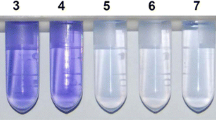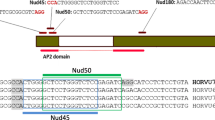Abstract
Whether the caryopsis of barley is naked or covered is controlled by the Nud gene encoding an ethylene response factor (ERF) family transcription factor (TF) of the AP2/ERF TF superfamily that is involved in the lipid biosynthesis pathway. In covered barley, lipids on the surface of caryopses act as a glue for their tight adhesion with hulls. Separation of hulls in naked barley is due to the absence of surface lipids on caryopses. A natural deletion event of Nud was found to be the determinant of naked caryopsis and had been proposed as the monophyletic origin of domesticated naked barley. In the present study, we re-sequenced the nud locus in 162 barleys, comprising 79 covered and 83 naked barleys varieties. Besides the normal deletion mutation of Nud contributing to naked caryopsis, we found a novel allele of Nud, designated as nud1.g, distinctly in three naked barleys collected from Tibet. nud1.g contains a non-synonymous SNP T643A when compared with the functional Nud gene. Genetic analysis indicated that the SNP T643A of nud1.g co-segregates with the naked phenotype. The nud1.g gene was expressed normally in the three naked barleys. Furthermore, in silico prediction of functionally conserved sites and 3D structures showed that the amino acid substitution (valine to aspartate) caused by SNP T643A may lead to a dramatic structural alteration of NUD that may result in loss of function. This study provides evidence of a new origin of the naked phenotype of domesticated barley in Tibet.






Similar content being viewed by others
References
Ashkenazy H, Erez E, Martz E, Pupko Ben-Tal N (2010) ConSurf 2010: calculating evolutionary conservation in sequence and structure of proteins and nucleic acids. Nucleic Acids Res 38:W529–W533
Dai F, Nevo E, Wu D, Comadran J, Zhou M, Qiu L, Chen Z, Beiles A, Chen G, Zhang G (2012) Tibet is one of the centers of domestication of cultivated barley. Proc Natl Acad Sci USA 109(42):16969–16973
Dai F, Chen ZH, Wang X et al (2014) Transcriptome profiling reveals mosaic genomic origins of modern cultivated barley. Proc Natl Acad Sci USA 111(37):13403–13408
Doyle JJ, Doyle JL (1990) Isolation of plant DNA from fresh tissue. Focus 12:13–15
Franckowiack JD, Konishi T (1997) Naked caryopsis. Barley Genet Newsl 26:51–52
Lister DL, Jones MK (2013) Is naked barley an eastern or a western crop? The combined evidence of archaeobotany and genetics. Veg Hist Archaeobot 22:439–446
Saisho D, Puruggana MD (2007) Molecular phylogeography of domesticated barley traces expansion of agriculture in the Old World. Genetics 1773(3):1765–1776
Taketa S, Amano S, Tsujino Y et al (2008) Barley grain with adhering hulls is controlled by an ERF family transcription factor gene regulating a lipid biosynthesis pathway. Proc Natl Acad Sci USA 105(10):4062–4067
Taketa S, You T, Yamashita Y et al (2013) Molecular mechanisms for covered vs. naked caryopsis in barley. Advance in Barley Sciences, Proceedings of 11th international barley genetics symposium, Zhejiang, China, pp 453–460
Zeng X, Long H, Wang Z et al (2015) The draft genome of Tibetan hulless barley reveals adaptive patterns to the high stressful Tibetan Plateau. Proc Natl Acad Sci USA 112(4):1095–1100
Acknowledgments
We thank Professor Lihua Chen, Qinghai Academy of Agriculture and Forestry Sciences for providing barley accessions with the name of WDMxxxx. This work was supported by the National Science and Technology Supporting Programs of China (2012BAD03B01).
Conflict of Interest
The authors declare that they have no conflict of interest.
Author information
Authors and Affiliations
Corresponding author
Additional information
Shuiyang Yu and Hai Long contributed equally to this work.
Electronic supplementary material
Below is the link to the electronic supplementary material.
ESM 1
(XLS 36 kb)
Rights and permissions
About this article
Cite this article
Yu, S., Long, H., Deng, G. et al. A Single Nucleotide Polymorphism of Nud Converts the Caryopsis Type of Barley (Hordeum Vulgare L.). Plant Mol Biol Rep 34, 242–248 (2016). https://doi.org/10.1007/s11105-015-0911-9
Published:
Issue Date:
DOI: https://doi.org/10.1007/s11105-015-0911-9




